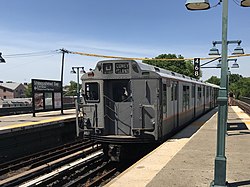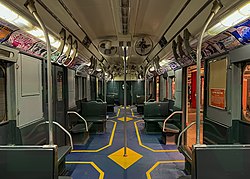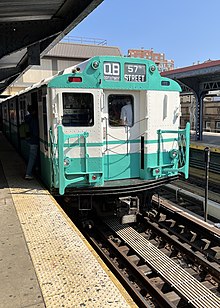
The R1 was the first New York City Subway car type built for the Independent Subway System (IND). 300 cars were manufactured between 1930 and 1931 by the American Car and Foundry Company, numbered 100 through 399, all arranged as single units. Nicknamed City Cars, the R1s were the first of five subway car classes collectively referred to as the R1–9 fleet, with future passenger stock orders – including contracts R4, R6, R7/A, and R9 – being virtually identical, with minor mechanical and cosmetic variations.

The R46 is a New York City Subway car model that was built by the Pullman Standard Company from 1975 to 1978 for the IND/BMT B Division. They replaced all remaining R1–9 fleet cars and General Electric-powered R16s, and some R10s. The R46 order initially consisted of 754 single cars, each 75 feet (23 m) long, and was the largest single order of passenger cars in United States railroad history at the point of the fleet's completion. The R46 was the second order of 75-foot cars to be ordered for the New York City Subway, after the R44s.

The R44 is a New York City Subway car model built by the St. Louis Car Company from 1971 to 1973 for the B Division and the Staten Island Railway (SIR). The cars replaced many R1-R9 series cars, and all remaining 1925 Standard Steel built SIRTOA ME-1 trains, providing Staten Island with a new fleet of railcars. The R44 fleet originally consisted of 352 cars, of which 57 remain in service, all on the Staten Island Railway.

The New York City Subway is a large rapid transit system and has a large fleet of electric multiple unit rolling stock. As of November 2016, the New York City Subway has 6418 cars on the roster.

The R1-9s were the 1,703 similar New York City Subway cars built between 1930 and 1940 for the Independent Subway System. All were built by the American Car and Foundry Company, the Pressed Steel Car Company, and Pullman Standard. The name comes from the literal spelling out of the final contract under which these 1,703 cars were ordered – contract "R9".

The R33S was a New York City Subway car that was built by St. Louis Car Company in 1963 for the IRT A Division. They were purchased for service on the IRT Flushing Line, which was the closest line to the 1964 New York World's Fair. A total of 40 cars were built, arranged as single cars. While in regular service, each R33S was coupled to five two-car consists of R36 cars to make 11-car trains for the 7 and <7> routes.

The New York Transit Museum is a museum that displays historical artifacts of the New York City Subway, bus, and commuter rail systems in the greater New York City metropolitan region. The main museum is located in the decommissioned Court Street subway station in Downtown Brooklyn and Brooklyn Heights in the New York City borough of Brooklyn. There is a smaller satellite Museum Annex in Grand Central Terminal in Midtown Manhattan. The museum is a self-supporting division of the Metropolitan Transportation Authority.

The R68A is a B Division New York City Subway car order consisting of 200 cars built between 1988 and 1989 by Kawasaki Railcar Company in Kobe, Japan, with final assembly done at the Kawasaki plant in Yonkers, New York. A total of 200 cars were built, arranged in four-car sets.

The R6 was a New York City Subway car model built from 1935 to 1936 for the city-operated Independent Subway System by three manufacturers under separate orders, the American Car and Foundry Company, Pullman Standard, and Pressed Steel Car Company. A total of 500 cars were built, numbered 900–1399, and arranged as single units. There were three versions of the R6: R6-1, R6-2, and R6-3. The R6s were a continuation of the R4 fleet and look almost the same, except that the R6 had a two-pane front window compared to the R4's one-pane window.
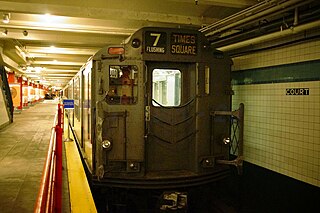
The R12 was a New York City Subway car built by the American Car and Foundry Company in 1948. A total of 100 cars were built, arranged as single units. Two versions were manufactured: Westinghouse (WH)-powered cars and General Electric (GE)-powered cars.

The R33 was a New York City Subway car model that was built by St. Louis Car Company in 1962 and 1963. The cars are a "follow-up" or supplemental stock for the A Division's R29s and closely resemble them. The cars were also referred to as R33MLs to distinguish them from the R33Ss. A total of 500 cars were built, numbered 8806–9305, and arranged in pairs.

The R16 was a New York City Subway car model built by the American Car and Foundry Company from 1954 to 1955 for the IND/BMT B Division. A total of 200 cars were built, arranged as single units. Two versions were manufactured: Westinghouse (WH)-powered cars and General Electric (GE)-powered cars.

The R27 was a New York City Subway car model built by the St. Louis Car Company from 1960 to 1961 for the IND/BMT B Division. A total of 230 cars were built, arranged in married pairs. Two versions were manufactured: Westinghouse (WH)-powered cars and General Electric (GE)-powered cars.

The R30 was a New York City Subway car model built by St. Louis Car Company from 1961 to 1962. The cars were a "follow-up" or supplemental stock for the B Division's R27s and closely resembled them. A total of 320 cars were built, arranged in married pairs. Three versions were manufactured: Westinghouse (WH)-powered cars, General Electric (GE)-powered cars, and R30As.

The R7 was a New York City Subway car model built from 1937 to 1938 for the city-operated Independent Subway System by two manufacturers under separate orders, the American Car and Foundry Company and Pullman Standard. They were a continuation of the R6 fleet and closely resemble them, except that the R7/As did not include the “CITY OF NEW YORK” lettering on the middle of the car exterior. A total of 250 cars were built, all arranged as single units. Two versions were ordered: the R7, which consisted of 150 cars, numbered 1400–1549, and the R7A, which consisted of 100 cars, numbered 1550–1649.

The R9 was a New York City Subway car model, which was built by the American Car and Foundry Company and the Pressed Steel Car Company in 1940 for the Independent Subway System (IND) and its successors, which included the New York City Board of Transportation and the New York City Transit Authority. Identical to the preceding R7/As, the R9s had distinctive curved ends on the rollsign boxes and contained distinct 2CY air compressors not featured on the older cars in the R1–9 fleet. A total of 153 cars were built, numbered 1650–1802, and arranged as single units. They were the last R1–9 type cars that were ordered before the merger of the IND with the IRT and BMT in 1940.

The R17 was a New York City Subway car model built by the St. Louis Car Company in 1954 for the IRT A Division. A total of 400 cars were built, arranged as single units. Two versions were manufactured: Westinghouse (WH)-powered cars and General Electric (GE)-powered cars.

The R26 was a New York City Subway car model built by American Car and Foundry from 1959 to 1960 for the IRT A Division. A total of 110 cars were built, arranged in married pairs.
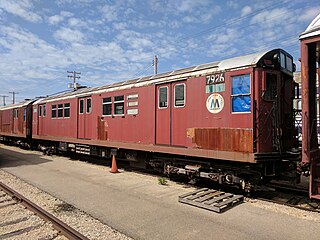
The R28 was a New York City Subway car model built by American Car and Foundry (ACF) from 1960 to 1961. The cars were a "follow-up" or supplemental stock for the A Division's R26s and closely resemble them. The average car cost per R28 was $114,495. A total of 100 cars were built, arranged in married pairs.

The World's Fair Lo-V was a New York City Subway car type built in 1938 by the St. Louis Car Company in St. Louis, Missouri. These 50 cars were ordered for the IRT Flushing Line in preparation for the 1939 World's Fair. They were the fourth and last "Lo-V" type cars that were ordered, and the last cars ordered for the IRT before the city takeover in 1940.
